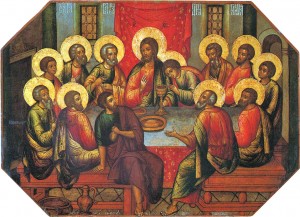On Holy Thursday, my family prepares for the evening Mass with a Passover reenactment and reflection. The super-rich evening liturgy assumes the Last Supper setting at every point, but we like to underscore that fact with a little drama in the home.
 These days a lot of people say that they do a Seder meal or that they do a “Christianized Passover” for Holy Thursday. I’m sorry, but those are both absurd things to say.
These days a lot of people say that they do a Seder meal or that they do a “Christianized Passover” for Holy Thursday. I’m sorry, but those are both absurd things to say.
On the one hand, the Seder is not a Passover meal, because the Passover was a sacrificial banquet, and for sacrifices you have to have the Temple. No, the Seder is a Jewish ritual that was invented after the destruction of the Temple and after Christ had ascended and Christianity was already being preached to the world as something different from Judaism. There is no reason a Christian would celebrate a Seder.
On the other hand, the “Christianized Passover” is the Mass. Christ himself “Christianized” the Passover, so it’s kind of silly for Christians to pretend to do that for him. If you want a Christianized Passover, go to the Holy Thursday evening liturgy.
What we do at home on Holy Thursday is best called a Passover re-enactment. We try to re-enact what Jesus and his disciples would have done at dinner that night as a way to prepare our minds for what the Church offers us in her liturgy. It’s a devotional prep for the evening. We look forward to it every year!
Here’s how we do it. Everyone who participates in the Passover re-enactment gets this slim handout, which explains both the actions and the foods; you can print it on one double-sided sheet. The cook will need this food list, which has some practical notes on how to prepare things. The leader can look at this really detailed overview of the Passover ceremony for background; at the end, I’ve tucked in a bibliography of sources I used in reconstructing the ritual. When I lead people through the devotion for the first time, I often base my comments on this article, which I published some time ago in the Homiletic and Pastoral Review.
Do you have any special family traditions for the Triduum? Let me know in the combox. I’d love new ideas for Holy Thursday and Good Friday in particular.


Not to nitpick too much, but it seems that if the Didache was compiled from ca. AD 70 through AD 95 (with its earliest bits from ca. AD 45), Christianity was still very much a part of Judaism and that only well after the Temple was destroyed, by the death of St. Ignatius around 108, was it something different. The impetus for considering Christianity to be distinct also seems to have been driven by the Jews who rejected Christ and reinforced when Christians had to deal with Judaizing.
Otherwise I agree with you and Dr. K.
Thanks for stopping by and leaving a comment! I appreciate hearing from you. I take it you refer to the line, “Christianity was already being preached to the world as something different from Judaism.” You’re absolutely right that this could use some nuance, inasmuch as outsiders still saw Christianity as more or less a sect of Judaism. As you know, the blog as a medium often loses something in the way of nuance as compared with a scholarly article or monograph. And yet I think that line is defensible. By the time the Seder meal was invented, Paul had already… Read more »
Very interesting to read about your family traditions! For the Triduum we use a flip book I made up, from 6pm on Holy Thursday through to Easter Sunday. It follows St. Alphonsus’s ‘Clock of the Passion of Our Lord Jesus Christ’. http://thewildestofadventures.blogspot.com.au/2015/03/a-pictorial-clock-of-passion-of-our.html?m=0 This link also has a link to download the booklet I made. It is quite possible that it will not hold up to professional scrutiny, but I am well pleased with it. We used it for the first time last year, and I would hear the children say things like ‘I wonder what Jesus is doing now?’. So… Read more »
Hi Sharyn, thanks for stopping by! Unless you object, I would like to add a link to your Lent page in my “Lenten Resources” list.
You are most welcome to! Glad you found it useful 🙂
“Begun the night before when he took the final “drink” from the cup of blessing when the sour wine was offered to Him on the sponge when he exclaimed, “I thirst.” His saying “It is finished” not only points to the fact that our salvation was now effected, but also to His Passover meal also being finished”.
Source:http://epicpew.com/catholic-facts-that-will-make-you-look-really-smart/